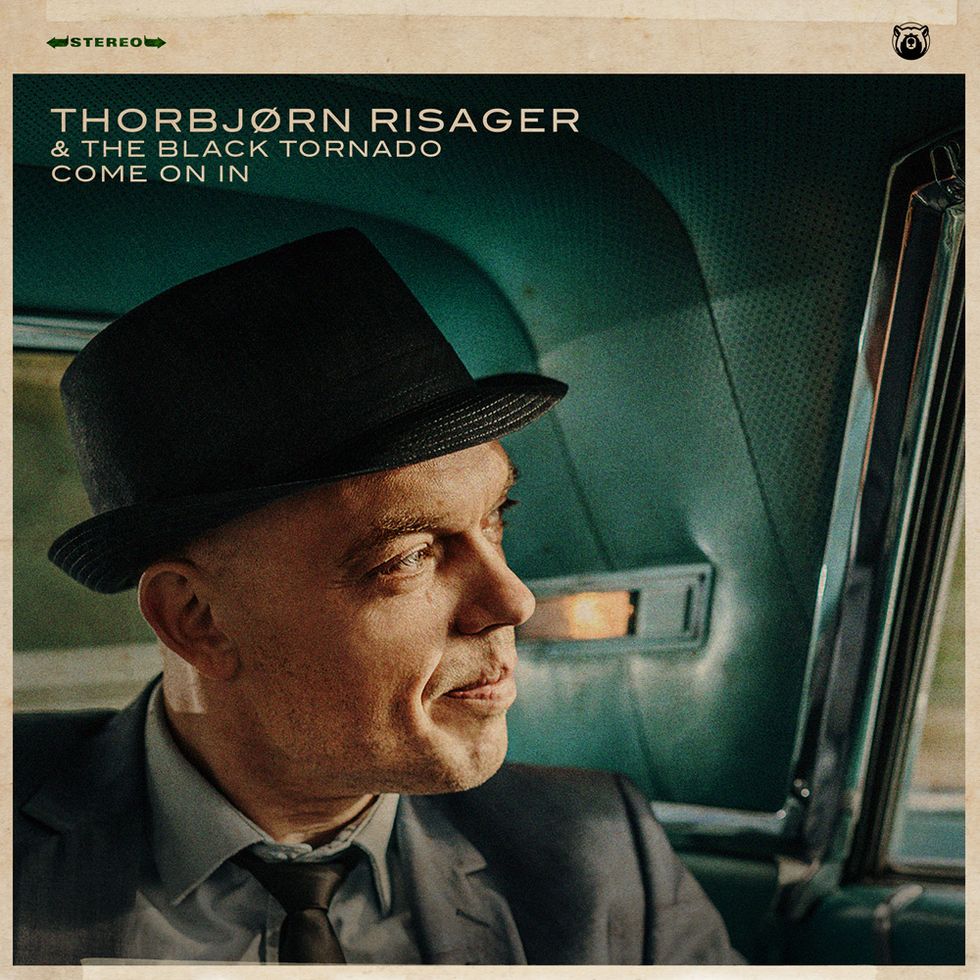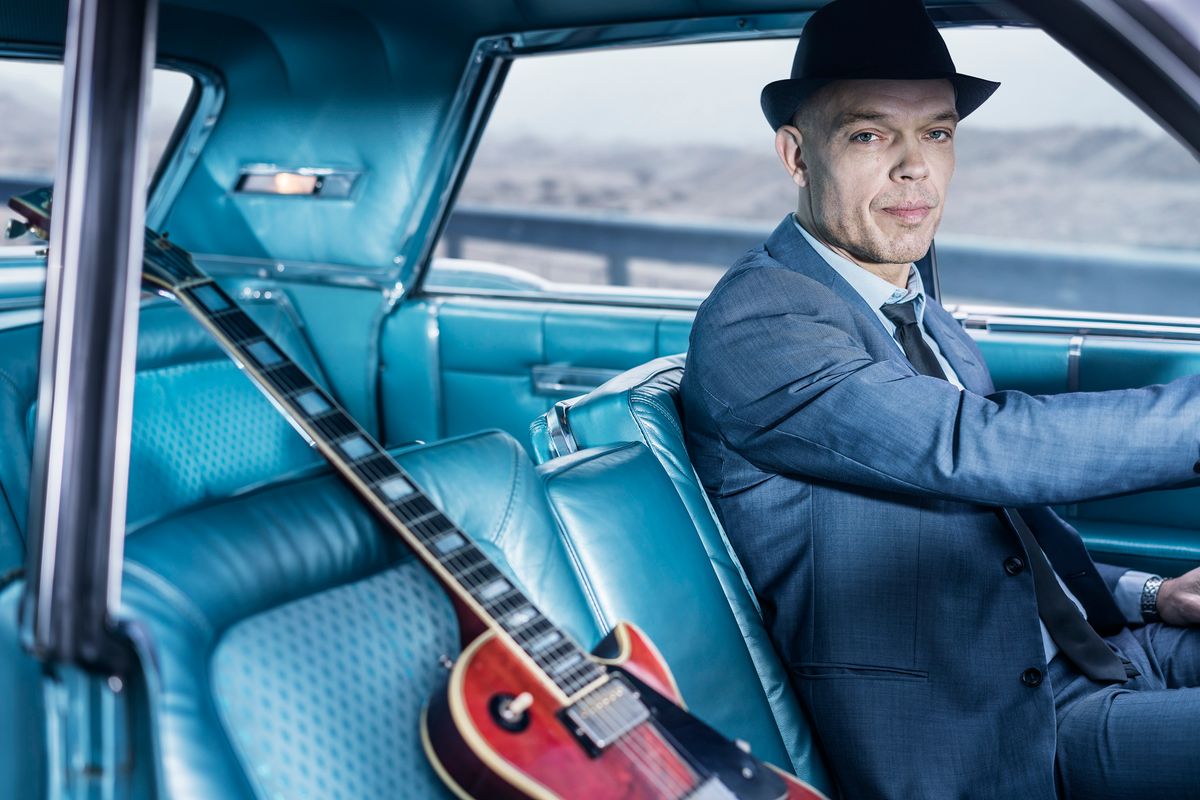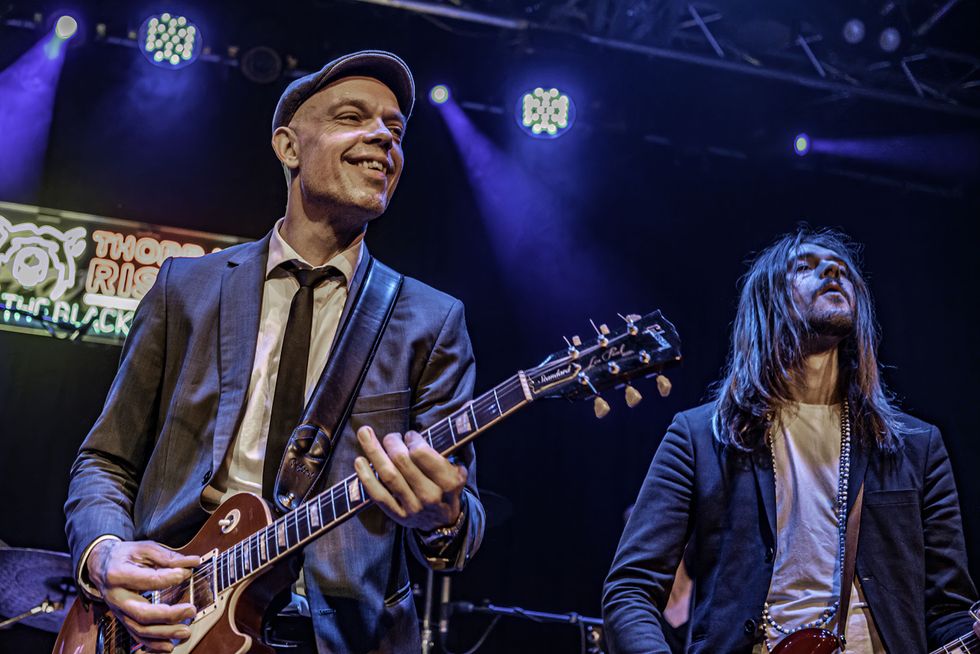The leader of Danish band the Black Tornado distills a range of influences from B.B. King to JJ Cale into a modern take on a classic genre.
The blues has been fiercely guarded by purists for the sake of authenticity, and also co-opted and twisted as a key ingredient of emerging genres. So the style’s evolution will always be as contested as it is inevitable. And a basic 12-bar will remain a first step on the path for many budding guitarists everywhere. Even Scandinavia.
For Danish singer-songwriter and guitarist Thorbjørn Risager, the blues is a lifelong calling that he’s treated with deep respect, but it’s also a form that he—backed by a six-piece band named the Black Tornado—has worked hard to infuse with a dose of modernity and a big boost of power.
Risager is relatively unknown to North American blues fans, but he and his group have been at it for more than 17 years and are a well-established live powerhouse in Europe that plays around 100 shows annually and has 11 albums to their credit. The latest is Come on In, and it finds the gruff and soulful singer’s commanding voice taking center stage. The album is a focused and beautifully recorded document of this outfit’s uniquely refined and potent take on blues, with 10 tunes that proudly display the lessons Risager’s gleaned from studying B.B. King’s bombast, Billy Gibbons’ relentless Texas boogie, and Ray Charles’ gospel fire, which he juxtaposes against cinematic textures and decorates with subtle effects. Come on In is an album that’s undeniably contemporary, but also quite timeless.
While Risager identifies as a singer first—and his husky voice is, indeed, very special—the man’s guitar skills are formidable and provide a perfect extension of his vocalese. Much in the way King’s guitar would take the reins from his voice to communicate where words failed, Risager, often armed with a red Varitone-equipped Greco ES-345 replica, is always good for a moving, emotionally-charged solo.
For the higher-octane rock playing on Come on In and for live appearances, Risager calls upon the talents of his guitar foil in the Black Tornado, Joachim Svensmark, who joined the group in early 2019 (replacing Peter Skjerning). Svensmark has an athletic playing style that brilliantly complements his boss’ fiery simplicity. The pair represent the duality of blues guitar, its past and its future, and some real magic happens when they dance together within Risager’s songs.
As Come on In, with its JJ Cale-influenced title track, begins to make the kind of noise that may well finally deliver Risager and company across the Atlantic, back to the cradle of the blues, PG spoke with the sharp-dressed Dane about creating the new album, how the blues took such a deep foothold in Scandinavia, and what it was like sharing the stage with Buddy Guy at a massive blues festival in India, of all places.
There’s still a narrative in blues where a lot of people want to keep it as “authentic” as possible for the sake of “keeping the blues alive.” You’re obviously a true student of the form, and I’m curious where and how you draw the line in trying to modernize it?
That’s a good question! I really try to avoid writing straight 12-bar blues tunes, and there’s only one basic 12-bar blues on the record, “I'll Be Gone.” A lot of it has to do with the sounds you use. For instance, our guitar player, Joachim, uses a lot of modern sounds and tones—sounds like you’d get from keyboards and sequencers and stuff like that. So, one way to go about it is just modernizing the tones in the colors you play with. Our bass player, Søren [Bøjgaard], is really the wizard behind our production and has always done a great job getting us sounds that are modern without going too far overboard.
When I write the songs, I’m not thinking about whether I want to do something that’s modern or not. It’s coming from my soul. Some of it also comes from what I’m listening to when I’m writing. On this record, I was listening to a lot of Bonnie Raitt, a lot of Ray Charles, a lot of Robert Cray … and all of these people mixed genres a bit, like I do. While it’s not something I think about when I’m writing the songs, we arrange them as a band and some of the guys in the band do think about how we can give the songs a more modern sound.
Can you tell me about the guitars you used on the new album?
I mostly used my Les Paul Standard. I don’t know much about it, because I’m a bit unusual as a guitarist as I’m not so interested in the equipment. I’ve always considered myself more of a singer, and the guitar equipment always came secondary for me. So I don’t know what year it is, but it’s a fairly new one. I chose to play a Les Paul this time and switched from using my Greco ES-345 copy. B.B. King is my favorite bluesman, and I thought I must play the same guitar as B.B., so I started playing the ES-345.
The record we made in 2014, Too Many Roads, has a song that sounded a little like ZZ Top, and I really love ZZ Top. When we recorded it, I asked the engineer if he could help the guitar sound be a little bit more like Billy Gibbons, and he said “Well, you really have to have a Les Paul for that.” So he gave me a Les Paul to use and I played that on the album and it took me a year or so to actually buy a Les Paul of my own, but now I have it and I really like it. I appreciate Billy Gibbons’ playing as much as B.B. King’s, though B.B. is really who I look up to as a singer.

TIDBIT: Danish bluesman Thorbjørn Risager’s 11th album, Come on In, has elements of B.B. King, ZZ Top boogie, and Ray Charles’ gospel juxtaposed with modern takes on the blues genre.
B.B., Freddie, and Albert King’s influence all come through in your playing. What is it about B.B.’s guitar work that speaks to you?
Well, definitely the simplicity of it. And his feel, of course. B.B. could bend just the root note of a progression and you’d know it was him playing the second you heard it, just from all the feeling that he could put behind a note. I saw him perform just two years before he passed away, and what really struck me was there was still so much power and soul in his singing at that age. That was really unbelievable.
And what impact has Billy Gibbons had on you?
As a band leader, I really appreciate how tightly ZZ Top plays together. There’s an extreme tightness in that band that I really dig, and it’s so well arranged. Also, something I’ve learned from listening to ZZ Top is how to make the blues sound more modern without losing its soul. As much as I really love playing an old-style 12-bar blues, you have to try to take the blues into the present somehow, and that’s what ZZ Top’s been really good at. ZZ Top’s music is definitely still blues music and has always been, but it’s also something more than that and became its own thing. They’ve really taken the blues in a direction of their own and even when they do play a 12-bar, it’s got a different style. And again, I really love Billy Gibbons’ and Dusty Hill’s singing, which is really important to me.
You’ve had essentially the same band for 17 years, and it’s a big band at seven members including yourself. I find the blues is at its most potent when it’s sparse, and your music manages to retain a lot of that despite having so much going on sonically. How do you approach arranging these songs with a big band in mind?
That’s really the challenge. When I first set out to form the band, it was on the basis of listening to B.B. King. On a lot of his recordings, he had pretty much the same lineup, with two horns and two guitars, a piano player, bass, and drums. I really, really loved B.B.’s The Best of the Kent Singles, so this band is based on that lineup. It’s constant work to keep everyone from playing at the same time and to arrange things in a way that lets the music breathe. It’s something we’re really aware that we have to try to avoid. Sometimes someone might think that someone else should take a break other than them, and everybody obviously wants to play, so that’s a constant fight—to try to have air and negative space in the music. But it’s so incredibly important. I still think that we have more work to do on that and I still think there’s space for more air in our music.
The album has a lot of very cinematic, almost Spaghetti Western-sounding guitar, like the tremolo-and-reverb-drenched stabs on the title track or the bridge of “Two Lovers.” How does that come into your writing?
That stuff is all Joachim! I actually play mostly acoustic guitar on the album. I don’t use a lot of effects in my electric guitar playing, either, but Joachim is very good at using them. I’m really glad to have him in the band, because he understands where I’m coming from musically, but can add those things in an interesting way that doesn’t overtake a song.
Thorbjørn Risager and Joachim Svensmark switch off playing lead and rhythm guitar. “He was a child prodigy and when we first met—a 13-year-old playing in our local blues club,” Risager says of Svensmark. “He sounded exactly like Stevie Ray Vaughan, which was unbelievable.” Photo by John Hurd
Which acoustic guitars did you use on the album?
I have a Lowden, which is made in Ireland. Unfortunately, I don’t know which model, but it’s a great guitar and I used that one a lot on the album. They also have some great acoustic guitars in the studio we worked in, including a vintage big-bodied Gibson that had old strings on it and had a more dirty, bluesy sound.
One of my favorite tracks is “Love so Fine.” Could you tell about writing that tune?
That’s definitely one where you can hear the ZZ Top in my music. We try to have a real blues-rock boogie song with that kind of feel on every album, and, for me, ZZ Top perfected the blues-rock thing. Honestly, that song could use a little more air in how it was mixed and produced, but it certainly gets that sound down and it’s a fun one to play live.
How do you and Joachim complement each other on guitar?
We like to switch off between playing lead and rhythm guitar. While he plays more solos than I do, we share our duties. One thing he does really well is play really long solos without boring anyone or really repeating himself. My solos are much more simple.
One funny thing we’ve found is that if I’ve written a song and there’s a particular riff that’s carrying the song, it always works better if I’m the one playing the riff. It rarely works if somebody else has to play it. It might be something in my sense of rhythm. If we want to impress the audience, Joachim’s there to put the flash in things. He was a child prodigy and when we first met—a 13-year-old playing in our local blues club. He sounded exactly like Stevie Ray Vaughan, which was unbelievable as a 13-year-old kid … a true wonder boy. Now he’s developed his own unique style, but his main influences are SRV and Jimi Hendrix. So we’re coming from different places as guitarists, but we’re both rooted in the blues. When it comes time for him to play a solo or write a part, I let him do his thing. I might coach a bit on him having another take in him, but I give him space to work.
I think a lot of our readers would be surprised to find there’s such a deep blues tradition and reverence for the music in Denmark and Scandinavia. Could you tell us about the scene and how you got involved in it?
I’m not sure I can explain why entirely, but Danish people do have a love affair with American blues. I live in Copenhagen, which has been known as a big jazz city for a very long time. A lot of American jazz musicians came over and lived here, like Ben Webster and Dexter Gordon. The same goes for some of the famous blues guys. For example, there’s a great Big Bill Broonzy live album recorded at a club in Copenhagen, which I love. I think part of it is that they were really acknowledged and treated nicely, not to mention paid well, over here. Most of them made much better money in Denmark in their time than they did in the States. And we still find that as musicians today, the places that treat us the best are Scandinavia and Germany. Everywhere else tends to be just a little more shitty when it comes to how the conditions are.
It also has something to do with blues being a little exotic and interesting, as it’s foreign to us, of course. It’s difficult to say why people so far away from the United States fall so deeply in love with music that is essentially American folk music. Blues, jazz, soul, funk—all of these are African-American art forms and, to my ears, the greatest music in the world. It’s one of those things that doesn’t really need to be analyzed too much, because it’s somehow universal.
I found the blues at my childhood neighbor’s house. My parents listened to mostly classical music, but my neighbors listened to blues. It’s still a big wonder to me why I fell in love with this music, because I was 10 years old, but I just had to get ahold of the music that I had heard at their house—especially Fats Domino and Muddy Waters. I had to get my hands on it somehow and bring it home and dissect it. Most people my age at that time were listening to things like Duran Duran, so it remains a mystery why it spoke to me so deeply. Later in life, I went to music school and that’s when I started playing guitar and got into Stevie Ray Vaughan, who was very important to me in the beginning of my education.

Guitars
Late 2000s Gibson Les Paul Standard
Vintage Greco SA-800 Vintage ES-345 Replica
Lowden acoustic
Amps
Fender Hot Rod Deluxe
Effects
Woodsound Wood Boost
Barber LTD overdrive
Boss TU-3 Tuner
Strings and Picks
John Pearse (.011–.050)
Could you tell us about some of the musicians in the Danish blues scene that have influenced you?
Actually, this guy originated in the United States, but he’s been living in Copenhagen since he was about 10 years old: Paul Banks. His first albums, which are the ones I really love, you sadly can’t get ahold of anymore. There’s one called Desperados in Disguise,and he’s a really incredible guitar player! I can’t recommend his records enough.
I really dig the guitar tones you get in your live videos. What amp do you use on the road?
I’ve played through a tweed-covered Fender Hot Rod Deluxe live for around 12 years, and that’s definitely my favorite amp. I’ve played hundreds and hundreds of gigs with that amp and it still works great! Incredibly strong amp.
I set my amp for a clean sound. I have a pedalboard, but it’s very simple. I use a tuner and a pedal called a Wood Boost, which is made at my local guitar store, Wood Sound, and increases the volume a little bit and gives it a little more crunch. And I also use a little overdrive pedal that adds some gain to the sound that I leave on all the time. I can’t recall the name of it.
As far as strings go, I prefer to use John Pearse brand .011s. I tried .010s once, and I really didn’t like the way they sounded. I’d read that Billy Gibbons uses extremely light strings, and I thought maybe I should try a lighter gauge and see if I like it, but it changed the sound much more than I expected. The guitar lost a lot of its bottom end.
Tell us about performing with Buddy Guy at the Mahindra Blues Festival in Mumbai, India. That sounds like such a wild experience.
That was a really great surprise! We didn’t know what to expect going into that show, or whether the audience would dig our music or even understand what we were saying onstage. Usually, we like to have a lot of interaction with the audience during our shows and it’s a big part of what we do. So we were very excited to see how they would react, and they were a really great crowd. They really dug the music and it was like playing for any European audience. It was just great!
I can’t exactly remember how the jam with Buddy Guy was set up, but we played at around 6 p.m., and Buddy wasn’t going on until 10 p.m. So, I had to wait for three hours after our set, and no one would say anything about when they were going to call me onstage or what songs we were going to play, so I was a bit of a nervous wreck. I was also nervous because at the time I was playing my Greco ES-345 copy, and that guitar is wired with a Varitone like a proper 345, so it needs a specific cable to work and sound right because it won’t give you a normal pickup selection from the input jack without it. I was really nervous about the technicians putting my gear up correctly with that special cable, and I couldn’t stop thinking about how awful it would be to get up onstage with Buddy Guy and not have my guitar work properly. In the end, everything worked out great and I had my sound right away and we played “Sweet Home Chicago” and another tune. There’s absolutely nothing quite like being onstage with a legend like that. It was an incredible moment, beyond words!
This full-length concert video from the long-running, prestigious German Rockpalast TV concert series captures Thorbjørn Risager and Peter Skjerning trading licks and leads as Thorbjørn Risager & the Black Tornado play Bonn’s 2016 Crossroads Festival.




